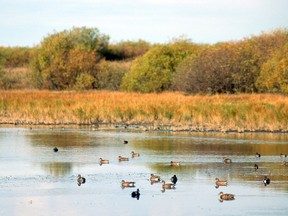Opinion: Stop forcing farmers to choose between economic viability and wetland protection

Article content
The Alberta earth is greening again. Farmers are back on the land seeding their crops. In the skies above, pintail, teal, northern shoveler and mallard ducks wheel before dropping into temporary sloughs, key components of their territories for nesting season.
Such shallow wetlands are usually wet for only a few months a year, but they are vital to the future of scores of prairie plants and animals, notably nesting birds. But shallow wetlands are becoming less common on the prairies, the result of an unfair choice. Every year, farmers face the same question: permanently drain those shallow wetlands to increase seeded acres and gross revenues to offset rising production costs, or farm around them?
This troubling “choice” has led to a significant annual loss of shallow wetlands on cropped lands. It also brings into focus the critical role that private landowners play in the habitat conservation that benefits all Albertans. It’s wrong to force that decision solely on nature-loving landowners. Economic viability for farm families and the preservation of shallow wetlands shouldn’t be at odds. The solution is to fairly compensate farmers for keeping temporary and seasonal wetlands in place.
Manitoba is already doing it. Farmers, conservation organizations and the provincial government are working together to pay farmers, based on a percentage of market land rental rates, for the acres of shallow wetlands conserved. The Manitoba approach was to place $204 million in a trust, which generates between $8 million and $10 million a year, used to compensate eligible farmers through local watershed districts. The program is completely voluntary, which is part of the reason for its overwhelming success. Many farmers are understandably skeptical of conservation approaches that tie their hands or that otherwise limit the use of their land.
The Manitoba approach allows producers to farm through these wetlands as conditions allow and as they have done for decades. And the wetlands provide other benefits, such as flood mitigation, retaining nutrients such as phosphorus, ensuring they don’t get into waterways where they can cause algae blooms, a major problem in many of Alberta’s recreational lakes. They also make a significant dent in GHG emissions by capturing and storing carbon from the air and naturally sequestering it in the roots of aquatic plants and in the soil itself. Finally, wetlands provide recreational opportunities for everyone from duck hunters to bird watchers.
At times, Alberta has led innovation in conservation. In 1997, the government of premier Ralph Klein created the Alberta Conservation Association. Today, this unique conservation partnership comprises hunting and fishing groups, Nature Alberta, agricultural producers and the provincial government, all banding together to ensure efficient use of resources, co-operation in scientific research and alignment in the approach to conservation. Alberta can lead again on conservation policy, by building on what Manitoba has already set in motion. And it needs to happen soon. Alberta continues to lose wetlands, especially on our croplands. The annual rate of wetlands loss in Alberta is estimated to be 0.37 per cent, with a higher rate of 0.88 per cent for those in cropland.
It is a joy and a privilege to live on and steward the land that is home to ducks, shorebirds, songbirds and so much more. And it’s an experience that we also owe to our children and grandchildren. It’s only right for society to work with farmers by providing compensation to preserve our natural heritage and share in the costs and benefits of wetland conservation. Adopting that policy will require vision and action, and an Alberta government that’s determined to lead.
Guy Anderson is a third-generation farmer and conservationist who farms with his wife, Maxine, on their 2,400 acre grain and forage operation near Camrose.






Postmedia is committed to maintaining a lively but civil forum for discussion. Please keep comments relevant and respectful. Comments may take up to an hour to appear on the site. You will receive an email if there is a reply to your comment, an update to a thread you follow or if a user you follow comments. Visit our Community Guidelines for more information.